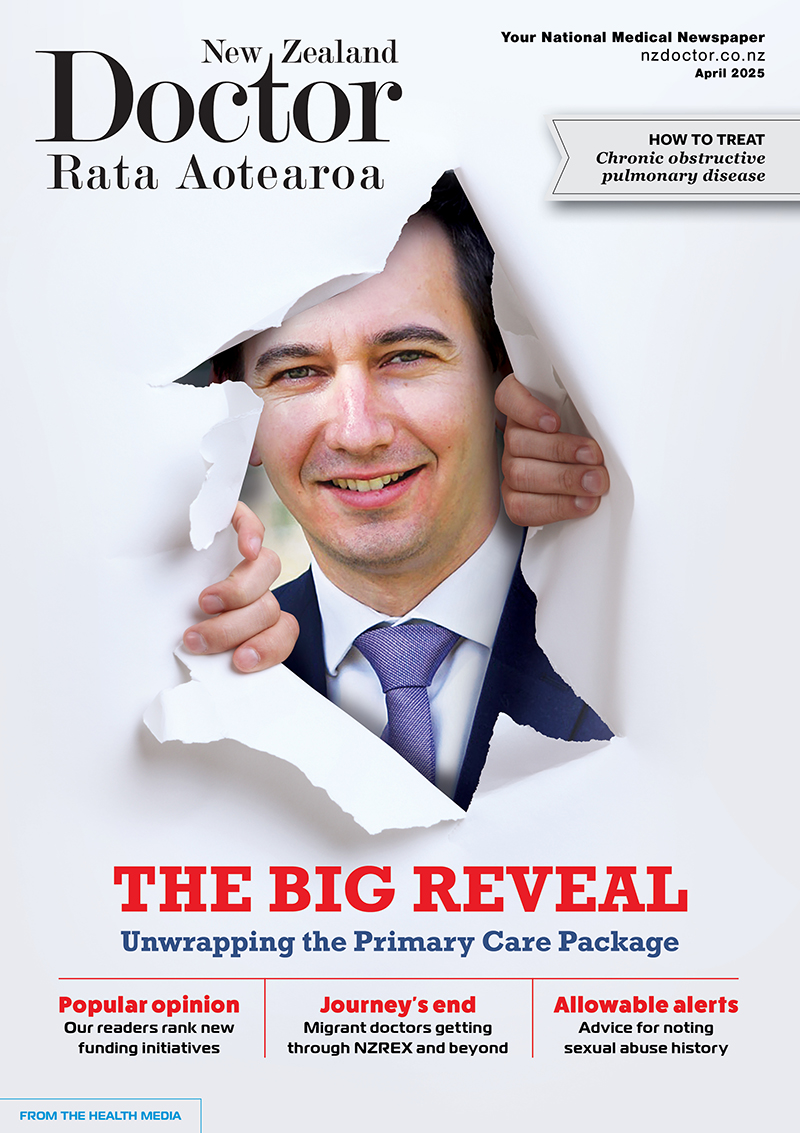Respiratory physician Lutz Beckert considers chronic obstructive pulmonary disease management, including the prevention of COPD, the importance of smoking cessation and pulmonary rehabilitation, and the lifesaving potential of addressing treatable traits. He also discusses the logic of inhaler therapy, moving from single therapy to dual and triple therapy when indicated, as well as other aspects of management
Heart failure
Heart failure

Pharmacist prescribers Linda Bryant and Leanne Te Karu discuss positive polypharmacy for heart failure. Current evidence shows the intensive implementation of four medications offers the greatest benefit to most patients with heart failure, with significant reductions in cardiovascular mortality, heart failure hospitalisations and all-cause mortality
This How to Treat has been endorsed by the RNZCGP and has been approved for up to 2 credits for continuing professional development purposes (2 credits per learning hour). To claim your CPD credits, complete the assessment at the end of this page, then log in to your Te Whanake dashboard and record this activity under the appropriate learning category.
Other healthcare providers may also find that reading this article and reflecting on their learning can count as a professional development activity with their own professional association.
At the end of this course, you should be able to:
-
Describe the four pillars of pharmacotherapy for heart failure with reduced ejection fraction
-
Explain how the four pillars should be initiated and optimised
-
Discuss barriers to optimal treatment for people with heart failure and how you might overcome these
- Empagliflozin is now funded for people with heart failure in absence of diabetes.
- The recommendation is to implement all four pillars of pharmacological intervention for heart failure simultaneously.
- Ensuring the patient is well briefed and has family/whānau involvement is imperative.
- Using the whole team and relationships within the community (eg, Māori and Pacific health providers) can be very helpful for management.
- Start with an audit of patients with heart failure and build your experience.
You are aware of Pharmac’s recent decision to widen access to empagliflozin for people with chronic heart failure with reduced ejection fraction (HFrEF) from 1 December 2024 (tinyurl.com/empagliflozin-decision).
After being exposed to multiple presentations and articles about heart failure and the need for early intervention with the “four pillars” of medications (also known as guideline-directed medical therapy), you decide to test the process and review a relatively straightforward person with heart failure. You aim to optimise pharmacotherapy so they receive the four guideline-recommended medicines at the maximum tolerated doses.
By summarising the pertinent evidence from the presentations and readings, you consolidate your understanding of the pharmacotherapy for heart failure in Aotearoa New Zealand.
1. The three-year mortality rate for New York Heart Association class I and II heart failure is 34 per cent, and for NYHA class III and IV heart failure, it is 42 per cent. The five-year mortality after a diagnosis of HFrEF is 50 per cent across all NYHA classes.1
2. The four pillars of therapy for HFrEF are:
- an angiotensin receptor–neprilysin inhibitor (ARNI) – sacubitril 97mg + valsartan 103mg twice daily
- a beta-blocker at maximum dosage
- a mineralocorticoid receptor antagonist (MRA) – spironolactone 25mg daily
- a sodium–glucose cotransporter-2 (SGLT2) inhibitor – empagliflozin 10mg daily.
We have got to this point following several landmark trials. For example, the PARADIGM-HF trial found that for sacubitril + valsartan, compared with taking an ACE inhibitor, the five-year estimated number needed to treat (NNT) to prevent one all-cause death is 21, and to prevent one cardiovascular death or heart failure hospitalisation, it is 14.2
For the newest addition to heart failure pharmacotherapy, the EMPEROR-Reduced trial provided evidence that empagliflozin reduces morbidity and mortality in people with HFrEF. For empagliflozin compared with placebo, the NNT to prevent one cardiovascular death or heart failure hospitalisation is 19, plus there is a benefit for renal outcomes.3
A 2022 meta-analysis showed the benefit of the medicines is cumulative for reducing cardiovascular mortality or heart failure hospitalisation (see figure). All-cause mortality is also lowest when all four medicines are taken together, with a hazard ratio of 0.39 (ie, approximately 60 per cent lower risk of all-cause mortality compared with placebo). The study found that if a 70-year-old with HFrEF is initiated on all four pillars of pharmacotherapy, life extension is an average of five years beyond that with no treatment.4
3. Early intervention, including starting all four pillars as soon as possible after diagnosis, is important and reduces mortality. This was demonstrated in the STRONG-HF study from 2022.
This study involved people hospitalised with heart failure who were randomised to usual care or high-intensity care with renin–angiotensin system inhibitors, beta-blockers and MRAs (up-titrated to 100 per cent of recommended doses within two weeks of discharge). At two weeks, more than 90 per cent of people in the high-intensity care group had achieved at least 50 per cent of these medicines’ optimal doses.5
At 90 days, a higher proportion of patients in the high-intensity care group had achieved full doses than in the control group (RAS inhibitors 55 versus 2 per cent; beta-blockers 49 versus 4 per cent; MRAs 84 versus 46 per cent).5
The study was terminated early because of the benefits of this intense, rapid optimisation of therapy. At 180 days, heart failure rehospitalisation or all-cause death had occurred in 15 per cent of the high-intensity care group compared with 23 per cent of the control group – an absolute risk reduction of 8 per cent (NNT 12.5). Quality of life in the high-intensity care group was also significantly improved.5
Within the high-intensity care group, people who achieved higher percentages of the optimal doses experienced greater improvements than those who achieved lower doses.5
At 90 days, the incidence of any adverse effect (eg, hypotension, hyperkalaemia) was higher in the high-intensity care group (41 per cent) than the control group (29 per cent), but there was no significant difference in serious adverse effects (16 per cent versus 17 per cent, respectively).5
This study was initiated prior to approval of SGLT2 inhibitors for treatment of heart failure, so only 5 per cent of participants were on an SGLT2 inhibitor, such as empagliflozin. However, it is expected the findings are also applicable to early initiation of SGLT2 inhibitors.
4. People with hypervolaemia should be treated with diuretics for symptom relief, but it is important to review this with the aim of reducing the medication as symptoms resolve. Just treating congestion by increasing furosemide dosage long term can be harmful.6 Instead, we should aim for treatment with the four pillars at maximum tolerated doses. Since some of these agents have a diuretic effect (eg, sacubitril + valsartan, MRAs, SGLT2 inhibitors), reduction or hopefully cessation of frusemide may be possible. Non-pharmacological measures also remain crucial in fluid balance maintenance.
Every heart failure phenotype has a risk of progression and adverse cardiovascular events, especially without optimal treatment
How will this work?
You still have questions about how this process will work in primary care.
How does the hospital-orientated STRONG-HF study convert to a primary care environment?
The concept of high-intensity care is established, but understandably, this may take a little longer in general practice. However, it will likely be easier to initiate the four pillars in a person who is stable and has not just been hospitalised with an exacerbation of heart failure.
The four pillars can be initiated in primary care (compared with when beta-blockers and ACE inhibitors first became guideline-directed therapy and had to be started in hospital), but perhaps a little more conservatively – for example, initially aim for optimisation over six to 12 weeks, depending on the starting point for the person.
What about appointment time? Engagement could be a long process, especially if the person with heart failure is relatively well.
A study of patient perspectives found approximately 75 per cent of people with heart failure wanted more information on the condition and its consequences, prognosis and treatment. GPs are a preferred source of information.7 Having a crib sheet with brief notes would be helpful.
The term heart failure makes it sound like the heart is no longer working and there is nothing that can be done. Actually, heart failure means the heart isn’t pumping as well as it should. There is also a misconception that heart failure can reach a “stable” state, and that people who are doing well do not need all therapies. However, every heart failure phenotype has a risk of progression and adverse cardiovascular events, especially without optimal treatment.
Medical caregivers need to understand and convey these messages to patients. Start the conversation early about heart “decline” as opposed to failure. At the time of diagnosis, there is the opportunity for a medicines therapy plan to be discussed with all patients.
Obtaining written information, such as from the Heart Foundation (heartfoundation.org.nz) or Healthify He Puna Waiora (healthify.nz/health-a-z/h/heart-failure), can be helpful. The first appointment may need to be a double appointment, or you can consider spreading this information over two or three appointments using the wider team, as resources allow.
How do we organise frequent primary care monitoring and follow-up (cost, personnel)?
This can be a major barrier for some people with heart failure – there is the time required for the appointments and travel to the clinic, coupled with the potential cost of visits.
Setting expectations is important, as implementing the four pillars involves six to 12 weeks of close monitoring and medication changes. Hence, the person needs to have a good understanding of the benefits that will occur, the monitoring required and the planned titration. Involving the wider whānau is proven and recommended.
Follow-up may be done via video, telephone or even email – a quick “touching base” to reduce the time commitment. If the person has a blood pressure monitoring machine and good-quality scales at home, this is much less time-consuming for you and them. Involving others (eg, medical care assistants, kaiawhina) for some of the clinical variable monitoring with report back can be helpful, as is collaboration with Māori and Pacific health providers.
Brief follow-up consultations may help reduce the cost, or perhaps a “package of care” cost would be acceptable. Ideally, the PHO would invest in heart failure as a clinical quality indicator and factor in the extra time.
Other clinicians could also assist – the practice-based clinical advisory pharmacist, pharmacist prescriber or nurse practitioner could monitor and titrate the medicines, and this has been successful elsewhere.
In the long term, intense input when the diagnosis of heart failure is made and optimisation of pharmacotherapy with the four pillars would mean fewer acute visits for exacerbations of heart failure.
How will you identify people with heart failure?
Doing a practice management system query for people with heart failure will identify those who will benefit and be the first pass of a clinical audit. As you work through the list while you gain experience, you could start with the people in whom the least medicine changes are necessary, while recognising the most significant benefit is in those at greatest risk. Initially, while establishing the system, gaining clinical confidence and finding the most valuable resources, less complexity is preferable. You can discuss self-funding with those who do not meet the Special Authority criteria for this combination of medicines.
Bob is a 67-year-old man who had a myocardial infarction 3.5 years ago. He has prediabetes and gastro-oesophageal reflux disease. He is currently prescribed bisoprolol 2.5mg daily, candesartan 8mg daily, furosemide 80mg every morning, atorvastatin 80mg daily, aspirin 100mg daily and omeprazole 20mg daily.
He comes in for his regular three-month check-up. He mentions that he is becoming more fatigued, which is impeding his physical activity. He tends to get short of breath and needs two pillows to sleep.
Investigations over the last six months:
- blood pressure 115–125/65–70mmHg (no postural drop)
- heart rate 80–88bpm
- oxygen saturation 94–96 per cent
- weight 78–80kg (dry weight 78kg)
- estimated glomerular filtration rate 45–50ml/min/1.73m2
- low-density lipoprotein cholesterol 1.3mmol/L
- HbA1c 45mmol/mol
- Left ventricular ejection fraction on echocardiogram 32 per cent.
Your plan
There is no clear guidance for initiating and optimising the recommended medicines, just to get all four on board at once and to titrate as permitted by response. Historically, the practice was to introduce the medicines one by one. However, this approach can take six months or more to achieve both the optimal doses and benefits of the four pillars of therapy (including reduced hospitalisations and mortality).
Clinically meaningful benefit has been demonstrated within days to weeks of initiation for each of the four medicine classes, suggesting delays needlessly expose people to risk.8 It is also considered better to be using all four pillars at the starting dose than one at maximal dose, as you are then covering all five pathways these medicines act upon rather than just one.
Bob is already on a beta-blocker and an angiotensin receptor blocker, so he will require three new medicines, with one just being a switch from the ARB candesartan to the ARNI sacubitril + valsartan. There is no need for a washout period when switching from an ARB, so Bob can transition to sacubitril + valsartan immediately (ie, when the next dose is due). To minimise the risk of angioedema, a washout period of at least 36 hours is required when switching from an ACE inhibitor to an ARNI.
With a documented left ventricular ejection fraction of 32 per cent, Bob meets the Special Authority criteria for both sacubitril + valsartan and empagliflozin. Empagliflozin can be initiated at the target dose for heart failure of 10mg daily without up-titration. Bob should also be initiated on the MRA spironolactone (eplerenone is an alternative MRA with less anti-androgenic adverse effects, available with Special Authority approval if spironolactone is not tolerated). Given both spironolactone and empagliflozin have diuretic properties, you reason that you should halve the current furosemide dose.
The table shows a draft plan for how you intend to approach this, with the titration dependent on Bob’s response to the medicines. There is flexibility to suit the person. Bob can set the pace, but the goal is maximum tolerated pharmacotherapy within 12 weeks. The draft does not allow more than four weeks between changes, and one to two weeks would be ideal.
Consultations may be virtual and involve the wider team
Setting expectations
After exploring Bob’s understanding of heart failure and the perceptions of his health, you note things to cover briefly. You are clear that follow-up discussions will occur, and you give him written information, such as the Heart Foundation’s Heart failure – daily checks record (tinyurl.com/HF-daily-checks).
You explain to Bob that he will not need to pay for the new medicines because he is eligible for Special Authority funding. He is also over 65, and copayments for prescriptions are not charged for this age group. This could be a major factor to consider if the person is less than 65 and doesn’t have a Community Services Card (which can be challenging to obtain).
It is important that Bob understands the rationale for what might seem like a lot of changes all at once. It is about ensuring maximal benefit – both quality and quantity of life (refer back to figure).
You explain the medicines will be titrated over the next six to 12 weeks, and Bob will be closely monitored. Consultations may be virtual and involve the wider team, and there will be laboratory tests to check kidneys and electrolytes.
If hypotension or postural hypotension occurs, the medicine(s) stopped depends on the person and is often based on morbidity and mortality benefit. For all-cause mortality, ARNIs (hazard ratio 0.75; 95 per cent confidence interval 0.66–0.85) and MRAs (hazard ratio 0.76; 95 per cent CI 0.67–0.85) are associated with the greatest benefit. However, all four medicines should be continued whenever possible, even if lower doses are used. It is also important to exclude other causes of hypotension, such as other medicines and conditions.
Follow-up visits
You obtain laboratory test results (eGFR, creatinine, urine albumin-to-creatinine ratio and electrolytes) one to two days before the appointment. This is where using the wider team can be helpful. At the appointment, you check weight, heart rate and blood pressure (both sitting and standing).
As with all prescribing, potential adverse reactions should be discussed, including Fournier gangrene – there have been case reports of this with empagliflozin in the absence of diabetes. You also provide sick-day advice.
Details changed to protect patient confidentiality
Linda Bryant is a pharmacist prescriber at Newtown Union Health Service and Porirua Union and Community Health Service
Leanne Te Karu is a pharmacist prescriber working across the Tūwharetoa and Waimarino areas
This 10-question multiple-choice assessment is designed to demonstrate that the provided educational reading has been effective in allowing you to meet the learning objectives of this course. Write down your answers to these questions.
1. Which of the following is not one of the four pillars of pharmacotherapy for heart failure with reduced ejection fraction?
a. Angiotensin receptor–neprilysin inhibitor
b. Beta-blocker
c. Diuretic
d. Mineralocorticoid receptor antagonist
e. Sodium–glucose cotransporter-2 inhibitor
2. What is the target dose of sacubitril + valsartan for chronic heart failure?
a. Sacubitril 49mg + valsartan 51mg once daily
b. Sacubitril 49mg + valsartan 51mg twice daily
c. Sacubitril 97mg + valsartan 103mg once daily
d. Sacubitril 97mg + valsartan 103mg twice daily
3. In primary care, over what time period should the four pillars be optimised?
a. Up to 2 weeks
b. Six to 12 weeks
c. Six to 12 months
4. Which two statements regarding the treatment of hypervolaemia in people with heart failure are correct?
a. Symptoms should be treated with a diuretic, with the aim of reducing the medication as symptoms resolve
b. Symptoms should be treated with a long-term diuretic at the maximum tolerated dose
c. Treatment with the four pillars can help with hypervolaemia due to the diuretic effects of some agents
d. With optimal pharmacotherapy, non-pharmacological measures are no longer an important part of fluid balance maintenance
5. Most people with heart failure want more information about the condition, and GPs are a preferred and trusted source of that information. True or False?
a. True
b. False
6. Which three statements regarding the conversations you should have with people with heart failure are correct?
a. Always check for patient understanding about heart failure
b. Always use the correct term – heart failure – as this is the most accurate and useful way to help patients understand their condition and its seriousness
c. Discuss a medicines therapy plan with all patients at the time of diagnosis – starting all four pillars as soon as possible after diagnosis is important
d. Educate patients that they will not need all therapies once they reach a stable state
e. It is helpful to involve whānau and provide written information to back up your conversations
7. Name two potential barriers to optimal treatment for people with heart failure.
8. Initiating and optimising the four pillars requires weeks of close monitoring and medication changes. Name one way you could reduce your time commitment.
9. Which two statements regarding initiation and optimisation of the four pillars are correct?
a. Empagliflozin requires up-titration to the target dose for heart failure
b. Eplerenone is an alternative MRA available with Special Authority approval if spironolactone is not tolerated
c. If the patient is taking a diuretic, the diuretic properties of some agents within the four pillars should be considered
d. It is better to use one medicine at maximal dose than all four pillars at the starting dose
10. For a patient already taking an ACE inhibitor, how should you initiate sacubitril + valsartan?
a. Add sacubitril + valsartan to their treatment regimen
c. Immediately switch to sacubitril + valsartan and stop the ACE inhibitor when the next dose is due
b. Switch to sacubitril + valsartan at least 36 hours after the last dose of ACE inhibitor
d. Up-titrate sacubitril + valsartan while down-titrating the ACE inhibitor
Write down your answers to these questions. Then, to check your answers and record your score, click here.
You can use the Capture button below to record your time spent reading and your answers to the following learning reflection questions, which align with Te Whanake reflection requirements (answer three or more):
- What were the key learnings from this activity?
- How does what you learnt benefit you, or why do you appreciate the learning?
- If you apply your learning, what are the benefits or implications for others?
- Think of a situation where you could apply this learning. What would you do differently now?
- If an opportunity to apply this learning comes up in the future, what measures can be taken to ensure the learning is applied?
- Can you think of any different ways you could apply this learning?
- Are there any skills you need to develop to apply this learning effectively?
We're publishing this article as a FREE READ so it is FREE to read and EASY to share more widely. Please support us and our primary care education resources – subscribe here
1. Davis M. Optimising outcomes in heart failure in 2023 and beyond. Research Review, 2023.
2. Srivastava PK, Claggett BL, Solomon SD, et al. Estimated 5-year number needed to treat to prevent cardiovascular death or heart failure hospitalization with angiotensin receptor-neprilysin inhibition vs standard therapy for patients with heart failure with reduced ejection fraction: An analysis of data from the PARADIGM-HF trial. JAMA Cardiol 2018;3(12):1226–31.
3. Packer M, Anker SD, Butler J, et al. Cardiovascular and renal outcomes with empagliflozin in heart failure. N Engl J Med 2020;383(15):1413–24.
4. Tromp J, Ouwerkerk W, van Veldhuisen DJ, et al. A systematic review and network meta-analysis of pharmacological treatment of heart failure with reduced ejection fraction. JACC Heart Fail 2022;10(2):73–84.
5. Mebazaa A, Davison B, Chioncel O, et al. Safety, tolerability and efficacy of up-titration of guideline-directed medical therapies for acute heart failure (STRONG-HF): a multinational, open-label, randomised, trial. Lancet 2022;400(10367):1938–52.
6. Friday JM, Cleland JGF, Pellicori P, et al. Loop diuretic therapy with or without heart failure: impact on prognosis. Eur Heart J 2024;45(37):3837–49.
7. Jankowska EA, Liu PP, Cowie MR, et al. Personalized care of patients with heart failure: are we ready for a REWOLUTION? Insights from two international surveys on healthcare professionals’ needs and patients’ perceptions. Eur J Heart Fail 2023;25(3):364–72.
8. Greene SJ, Ayodele I, Pierce JB, et al. Eligibility and projected benefits of rapid initiation of quadruple therapy for newly diagnosed heart failure. JACC Heart Fail 2024;12(8):1365–77.









![Barbara Fountain, editor of New Zealand Doctor Rata Aotearoa, and Paul Hutchison, GP and senior medical clinician at Tāmaki Health [Image: Simon Maude]](/sites/default/files/styles/thumbnail_cropped_100/public/2025-03/Barbara%20Fountain%2C%20editor%20of%20New%20Zealand%20Doctor%20Rata%20Aotearoa%2C%20and%20Paul%20Hutchison%2C%20GP%20and%20senior%20medical%20clinician%20at%20T%C4%81maki%20Health%20CR%20Simon%20Maude.jpg?itok=-HbQ1EYA)
![Lori Peters, NP and advanced health improvement practitioner at Mahitahi Hauora, and Jasper Nacilla, NP at The Terrace Medical Centre in Wellington [Image: Simon Maude]](/sites/default/files/styles/thumbnail_cropped_100/public/2025-03/2.%20Lori%20Peters%2C%20NP%20and%20advanced%20HIP%20at%20Mahitahi%20Hauora%2C%20and%20Jasper%20Nacilla%2C%20NP%20at%20The%20Terrace%20Medical%20Centre%20in%20Wellington%20CR%20Simon%20Maude.jpg?itok=sUfbsSF1)
![Ministry of Social Development health and disability coordinator Liz Williams, regional health advisors Mary Mojel and Larah Takarangi, and health and disability coordinators Rebecca Staunton and Myint Than Htut [Image: Simon Maude]](/sites/default/files/styles/thumbnail_cropped_100/public/2025-03/3.%20Ministry%20of%20Social%20Development%27s%20Liz%20Williams%2C%20Mary%20Mojel%2C%20Larah%20Takarangi%2C%20Rebecca%20Staunton%20and%20Myint%20Than%20Htut%20CR%20Simon%20Maude.jpg?itok=9ceOujzC)
![Locum GP Helen Fisher, with Te Kuiti Medical Centre NP Bridget Woodney [Image: Simon Maude]](/sites/default/files/styles/thumbnail_cropped_100/public/2025-03/4.%20Locum%20GP%20Helen%20Fisher%2C%20with%20Te%20Kuiti%20Medical%20Centre%20NP%20Bridget%20Woodney%20CR%20Simon%20Maude.jpg?itok=TJeODetm)
![Ruby Faulkner, GPEP2, with David Small, GPEP3 from The Doctors Greenmeadows in Napier [Image: Simon Maude]](/sites/default/files/styles/thumbnail_cropped_100/public/2025-03/5.%20Ruby%20Faulkner%2C%20GPEP2%2C%20with%20David%20Small%2C%20GPEP3%20from%20The%20Doctors%20Greenmeadows%20in%20Napier%20CR%20Simon%20Maude.jpg?itok=B0u4wsIs)
![Rochelle Langton and Libby Thomas, marketing advisors at the Medical Protection Society [Image: Simon Maude]](/sites/default/files/styles/thumbnail_cropped_100/public/2025-03/6.%20Rochelle%20Langton%20and%20Libby%20Thomas%2C%20marketing%20advisors%20at%20the%20Medical%20Protection%20Society%20CR%20Simon%20Maude.jpg?itok=r52_Cf74)
![Specialist GP Lucy Gibberd, medical advisor at MPS, and Zara Bolam, urgent-care specialist at The Nest Health Centre in Inglewood [Image: Simon Maude]](/sites/default/files/styles/thumbnail_cropped_100/public/2025-03/7.%20Specialist%20GP%20Lucy%20Gibberd%2C%20medical%20advisor%20at%20MPS%2C%20and%20Zara%20Bolam%2C%20urgent-care%20specialist%20at%20The%20Nest%20Health%20Centre%20in%20Inglewood%20CR%20Simon%20Maude.jpg?itok=z8eVoBU3)
![Olivia Blackmore and Trudee Sharp, NPs at Gore Health Centre, and Gaylene Hastie, NP at Queenstown Medical Centre [Image: Simon Maude]](/sites/default/files/styles/thumbnail_cropped_100/public/2025-03/8.%20Olivia%20Blackmore%20and%20Trudee%20Sharp%2C%20NPs%20at%20Gore%20Health%20Centre%2C%20and%20Gaylene%20Hastie%2C%20NP%20at%20Queenstown%20Medical%20Centre%20CR%20Simon%20Maude.jpg?itok=Z6u9d0XH)
![Mary Toloa, specialist GP at Porirua and Union Community Health Service in Wellington, Mara Coler, clinical pharmacist at Tū Ora Compass Health, and Bhavna Mistry, specialist GP at Porirua and Union Community Health Service [Image: Simon Maude]](/sites/default/files/styles/thumbnail_cropped_100/public/2025-03/9.%20Mary%20Toloa%2C%20Porirua%20and%20Union%20Community%20Health%20Service%20in%20Wellington%2C%20Mara%20Coler%2C%20T%C5%AB%20Ora%20Compass%20Health%2C%20and%20Bhavna%20Mistry%2C%20PUCHS%20CR%20Simon%20Maude.jpg?itok=kpChr0cc)